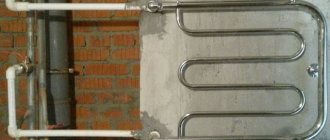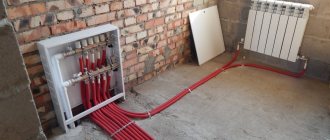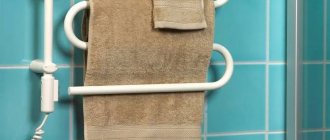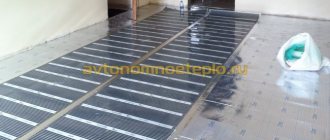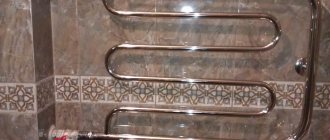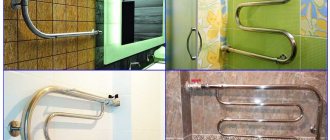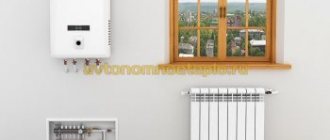In our country, in many regions there are harsh winters. Therefore, batteries are not capable of creating a comfortable and warm atmosphere in apartment buildings or private buildings. The solution is to build a heated water floor in the apartment.
In the bathroom, where additional heating is often required, you can install heated floors from a heated towel rail. They will ensure proper temperature and will not allow humidity to negatively affect the finishing of the room.
Installing heated floors in the bathroom: pros and cons
Do not connect the water circuit to the heating without permission from the relevant authorities.
You can easily install heated floors in your bathroom yourself. In apartments with central heating, it is illegal to change the heating system without the necessary permits.
If you independently, without the knowledge of certain authorities, make warm floors from central heating, then as a result the neighbors will complain that the apartments are quite cold, since the pressure in the pipes will drop. If it turns out that heated floors were made illegally, you will need to remove the system and pay a fine.
Considering these facts, in high-rise buildings it is recommended to begin installation only after the necessary documents and permits have been completed.
Two way valve
An alternative option could be electric floor heating systems.
If a water floor heating system is installed, a connection from a heated towel rail is often used in bathrooms. The main thing in this case is to take care not only of yourself, but also of your neighbors.
They may experience a decrease in battery temperatures. To avoid heat loss from other people, a two-way valve is installed.
Before installation, you should familiarize yourself with the disadvantages and advantages of the system, which are given in the table:
| № | Advantages | Flaws |
| 1 | The system is invisible to the eye and does not take up space like radiators. | The initial cost is quite high. |
| 2 | Taking a bath and being in the room is more pleasant when you stand on a warm floor. | Certain types of coatings cannot be installed with heated floors. But in the bathroom, as a rule, tiles are used, so there should not be any difficulties. |
| 3 | Fast payback of the heating system. |
If you do the installation yourself, the cost will be significantly reduced and you will only get positive emotions from the heating system.
You need to remember about permits that will protect you from paying fines when connecting the system to central heating, as well as from legal proceedings.
What it is
There are several types of heated floors, but water ones have gained the most popularity among us. Their demand is explained by profitable operation and energy saving.
It is fair to say that it is easier to install the system yourself in a private house than in an apartment. Whether it will be located in the bathroom or another room is a purely individual question.
When choosing a heated floor system, you need to take into account not only its cost in the store and installation price, but also the cost of operation. According to these indicators, water heated floors are noticeably ahead of their competitors
A water heating system in a bathroom or living space consists of polypropylene or metal-plastic pipes, thermal insulation, manifolds, fittings, and a thermostat. After proper installation, the heater will serve you for about 50 years.
Parallel connection of heated floors
Infrared film heated floor characteristics, calculation, connection diagram and installation
When connecting in parallel, tees are installed at the connection points of the heated towel rail. The underfloor heating circuit pipe is connected to them through shut-off valves. In this case, it is necessary to install one control valve to control the water flow through the circuit.
The disadvantage of this type of connection is the likelihood that an insufficient amount of coolant will pass through the floors. This is due to the fact that the circuit resistance exceeds the hydraulic resistance of the heated towel rail.
To establish high-quality circulation, you will have to limit the water flow through the substation and close the tap at the inlet or outlet of the heating device. This can cause a general decrease in flow through the riser and complaints from neighbors.
As a solution to this problem, you can install a low-power circulation pump. The unit will forcibly pump the coolant, but this will cause a small consumption of electrical energy. The power of the pumps for use in the described case is 50 – 70 W.
Combination methods
A heated towel rail is a specific heating device that heats a bathroom, used for drying a variety of small textiles. Warm floors are installed in tandem with a water appliance.
Heated towel rails can be connected to one of the following types of pipelines:
- to centralized heating - this is an extremely rare option;
- to the main riser;
- to the hot water recirculation branch.
These varieties differ in operating modes and diameter. If you connect a heated floor to the first option, it will heat only during the heating season. When introduced to the recirculation line, additional heating occurs when the taps are open. An alternating mode is formed when tied to a riser; this option is not rational, as it exhibits low productivity.
Warm floors are connected to the heated towel rail in parallel, in series or through a circulation station. The first two methods affect the hydraulic parameters of the riser. A circulation unit equipped with a heat exchanger allows you to separate the functionality of the heated towel rail and the heated floor circuit.
Parallel connection
It is implemented using tees: the pipe serving the underfloor heating is connected using shut-off valves. A mandatory component is a control valve that allows you to coordinate water flow.
The solution has a significant drawback: there is a high probability of an insufficient volume of coolant passing through the circuit. The reason for this effect is the hydraulic resistance of the circuit is higher than that of a heated towel rail. To ensure complete circulation of water, you will have to limit the flow of the latter by closing the inlet or outlet tap. But this measure may cause discontent among neighbors, since a general weakening of the flow is likely.
A solution could be a low-power circulation pump with a capacity of up to 50-70 W; it will forcibly pump the working environment. In this case, energy costs will arise.
Sequential
The junction point becomes the cut of the riser; in this scenario, both heating devices will function simultaneously. The riser is turned off, a section of the pipeline is cut out of it, a ball valve and valve (or 2 valves) are inserted into the cut, and the circuit pipeline is connected through them.
Installation diagram for underfloor heating from a heated towel rail
The disadvantage of the solution is the occurrence of large resistance in the operation of the riser. The effect will be enhanced if you tighten the control valve. The use of a circulation pump is not recommended here; it will only be an additional obstacle.
Scheme with heat exchanger
The optimal solution to the issue under consideration is to use a unit with a heat exchanger and a pump. The working medium circulating in the pipes of the circuit is heated by water in the heat exchanger. In such a connection, full hydraulic independence is formed.
It is recommended to connect the pump in series with the heated towel rail; in addition to the station, a bypass must be installed. Parallel implementation in this case is accompanied by the same disadvantages that are inherent in direct connection, one of them is an insufficient flow of heated liquid.
Connection diagram for coolant to hot water
How to make a warm floor from heating Warm water floor. Installation of heated floors
Many people are interested in the question of how to connect a heated towel rail to a hot water riser. Of course, here you need to follow certain instructions. All work will consist of several stages, namely:
- Removing the heated towel rail.
- Selecting a new location for its installation and marking the installation.
- Installation of shut-off valves.
- Installation of fasteners for heated towel rails.
Important! It is quite possible to install and connect a heated towel rail to hot water with your own hands. First of all, you should adhere to a certain scheme. So, first of all, experts recommend installing a bypass to the hot water riser, which will act as a jumper
The entire subsequent scheme looks very simple. When connecting a heated towel rail in the bathroom from the hot water supply, it will ensure the circulation of coolant through the heating system. First of all, you need to decide which type and design is best to choose. So, first of all, the coupling is connected. The diameter of the coupling will depend on the outlet to the heated towel rails and the hot water riser. You should also decide exactly how to install this device. So, if the length of the eyeliner reaches about 50 cm, then it is better to choose a horizontal installation.
So, first of all, experts recommend installing a bypass to the hot water riser, which will act as a jumper. The entire subsequent scheme looks very simple. When connecting a heated towel rail in the bathroom from the hot water supply, it will ensure the circulation of coolant through the heating system. First of all, you need to decide which type and design is best to choose. So, first of all, the coupling is connected. The diameter of the coupling will depend on the outlet to the heated towel rails and the hot water riser. You should also decide exactly how to install this device. So, if the length of the eyeliner reaches about 50 cm, then it is better to choose a horizontal installation.
Important! The ideal installation method would be one that allows the coolant to move from top to bottom. This will ensure uniform and high-quality heating.
Among other things, when installing a heated towel rail, it is important to maintain the exact distance from the wall to the pipe. As a rule, it will depend on the diameter of the coolant supply pipe. So, if the diameter is about 40 mm, then the distance should be about 550 mm. Hanging is carried out on special stops. To prevent deformation during the heating process, the fastening must be free. Once you have finished connecting the pipeline to the hot water supply, you can start the system to check its functionality. During the test run, it is important to ensure that all connections are absolutely tight. If there is even the slightest drip, then you will have to fix this leak. As you can see, connecting a heated towel rail to a hot water supply in a private house does not pose any particular problems.
Advice! When working, do not skimp on the quality of all initial building materials. This will allow you to eliminate possible problems when using the towel.
Now we invite you to familiarize yourself with common methods and diagrams for installing/connecting a towel. There are several effective ways to accomplish this task. We will look at the most common and popular ones. One way is to connect from below. Everything is very simple here. Hot water comes in on one side and comes out on the other side. A method of connecting from above is also known. For this purpose, a special entrance is used, located in the upper part. It is through it that the power supply will be carried out. Accordingly, on the other side there will be a coolant outlet. Another way to connect diagonally. For example, the water supply will be from above on one side, and diagonally on the other side of the device there will be an outlet at the bottom. Another connection scheme is to carry it out in the center. Special heated towel rails are even sold for this purpose. Their peculiarity is that fastening and installation is carried out on the lower crossbar. This method is especially suitable for cases where the equipment has the shape of a ladder.
Advice! If you have a single-point heated towel rail, then the connection is made at the bottom from one point. But this method is practiced extremely rarely. But some manufacturers offer similar products.
What to expect
We would like to immediately warn you that high-quality installation of heated floors from a towel dryer requires certain calculations, knowledge and skills, otherwise you will inevitably encounter the following problems:
Too hot towel dryer. A floor surface that is too hot can also become a problem if your appliance is working too hard. Sometimes it is not possible to reduce the temperature of the dryer, and then the whole installation does not make sense. In different buildings there may be problems with hot water, and if at the same time you have an underground structure, then it will make the surface not just cold, but icy
This point must also be taken into account during installation. The problem can be solved by installing a temperature control meter
If you do not work properly, you risk disrupting the normal supply and leaving both your own and your neighbors’ living space completely without hot water. Too much pressure in a set with an accidental kinking of pipes leads to a breakthrough of the entire structure, after which the illegal installation of the floor will be revealed and the results can be the most unpleasant. If you were planning to contact specialists, you will most likely receive a refusal, since, in general, companies do not want to get involved with criminal types of installation.
Warm floor from towel dryer
If you are not afraid of this kind of complexity, you can try installing a heated floor from a towel dryer yourself. There are several important connection types for this.
Types of heated towel rails
How to connect a heating cable to the network
A heated towel rail is a special type of radiator in the shape of a coil; the working fluid circulates through a curved pipe. The water model is used complete with fittings that provide connection to the hot water supply system; electric variations have a built-in heating element. The operating principle of both devices is the same: the pipe, heating up along with the energy carrier, dries the air in the room and removes moisture from hanging towels. In the standard version, the battery is fixed to the wall.
Water
It fits into the heating and hot water supply system; this is the most common design option. It is independent of power supply and has the following advantages:
- ease of execution,
- safety,
- unpretentiousness in maintenance,
- loyal price range and variety of models,
- effective completion of the assigned task.
But there are also weaknesses:
- complete dependence on the supply of hot water or heating;
- the formation of a layer of corrosion and scale from the inside, which affects the ability to heat the body.
Water heated towel rail
We must not forget that air pockets often form in such systems.
Electrical
They are full-fledged radiators with a closed circuit. Their dimensions are slightly larger (due to the design features), they can be installed in any area of the bathroom, as long as the cord reaches the outlet. Electric models can be oil-based, they are attractive due to their high heat capacity, and “dry” - they do not contain a working fluid, a cable is laid.
Advantages of the line:
- long service life;
- reliability in use;
- moderate energy consumption;
- The device can be turned on and off as needed.
The downside is complete dependence on the electricity supply; products are sold in a high price segment. Electrical variations can be supplemented with useful options - thermostat, timer, automatic safety equipment.
Electric heated towel rail
On the specialized market there are universal models that combine the positive properties of both categories; they are connected to the electrical network and heating. With the correct installation, the dryer will delight you all year round: in the summer from the mains, and in the winter from centralized heating. The only difficulty is choosing the optimal installation location.
Dismantling the old device
You should start by disassembling the old heated towel rail. For this:
- Having agreed with the neighbors at the entrance and the management company, we shut off the heating riser and drain the water from it.
- If the old structure was welded to the riser pipes, cut it off with a grinder. In the case of a detachable connection, unscrew the fastening couplings.
- In rare cases when the installation dimensions of a new device coincide with the old ones, we can consider ourselves very lucky. Most often this is not the case and you have to cut the pipes even with a collapsible connection.
- The cutout in the riser must be higher in height than the distance between the inlet pipes of the new heated towel rail by the length of the pipes and couplings required for inserting the bypass.
- When cutting, we take into account not only the installation dimensions of the new device, but also the possibility of cutting threads on pipes.
- We remove the old device from the wall by cutting off its brackets with a grinder or a hacksaw.
Operating principles of the heating system
This connection option does not pose any technical difficulties. A heated towel rail is a heating device installed in almost every city apartment. From a constructive point of view, this is an external element of communications through which hot coolant or hot water of the DHW system circulates. Such elements are often installed as a compensating loop of the heating system, playing the role of an additional source of heat in rooms with high humidity. The name of the element speaks for itself, hence the serpentine shape, thanks to which you can effectively use the heated circuit.
For aesthetics, heated towel rails are usually made of stainless steel or plated with nickel. The design itself and the method of connecting the heated towel rail to the centralized communication make it possible to connect a water floor pipe to it without much difficulty. As a rule, small diameter pipes are used for heated floors. For a bathroom, the area of which rarely exceeds 4-5 m2 in a city apartment, only 15-20 meters of pipe will be required.
There are two types of heated towel rails:
- a coil that is connected to a centralized heating system;
- a coil that is connected to a centralized hot water supply.
In the first case, with the onset of the heating season, water fills the heated towel rail and accordingly enters the heated floor circuit, heating the floor surface.
The first option only works during the heating season. The rest of the time your heated floor will be inactive. A coil connected to the DHW system looks preferable. Such a floor in the bathroom will always work, providing a good microclimate and comfortable temperature.
general information
With the adoption of SNiP 2.04.01‑85, in which the term “towel rail” appeared, the device soon came into general use.
Unaesthetically pleasing and, moreover, useless at the end of the heating season, iron structures painted with “silver” or nitro paint, nevertheless appealed to the taste of householders, and soon they began, by hook or by crook, to obtain and install nickel-plated, graceful, elegant and practical European units.
This topic has not lost its relevance even now: in the housing stock there are still many old buildings, where apartment owners, starting repairs or replacement of plumbing equipment, turn their attention to such useful and necessary devices for equipping a bathroom, which are quite within the capabilities of a home handyman. self-installation
Heated floor design instead of a heated towel rail
High-quality work directly depends on a properly installed substrate. It consists of 5 main components:
- insulation from possible leaks;
- metal mounting mesh;
- thermal insulation;
- damper tape compensating for various expansions;
- one type of screed (dry or wet).
On average, the thickness of such a substrate is 5–15 cm.
The essence of the design is that metal-plastic pipes are fixed together into fragments, placed on a substrate and fixed to the collectors. The coolant circulates through the latter, and the return is returned. Warm floors are a low-temperature design, because their heating does not exceed 45 °C.
Reference! For improved heating of the room, it is better to use ceramic tiles or concrete screed as a floor covering.
Advantages
- No interference with finishing the room;
- preservation and saving of heat consumption. This is especially true for rooms with high ceilings;
- Absolutely environmentally friendly. This design does not have a negative impact on human health.
Flaws
- Expensive installation of heated floors;
- administrative ban on installation of this structure;
- increase in floor weight due to layering of the substrate in the bathroom.
How to lay infrared film?
Preparatory work is carried out as in the version with cables. Sheets of film are laid parallel to the thermal insulation material, retreating approximately 20 cm from the wall. A distance of 30-50 mm is left between the strips of infrared fabric.
Laying sheets of infrared film overlapping is prohibited.
Next, a thermostat with a sensor is installed, then their functionality is checked.
Carefully cover the device with infrared film with a reinforcing mounting mesh so as not to touch the contacts, and secure it with self-tapping screws. The structure is filled with cement screed.
You need to wait until the concrete mortar has completely dried, then lay the tiles on the adhesive, which will be the finishing coating.
Specifics of installing a heated towel rail
The general principle of connecting any type of heated towel rail remains unchanged: water is supplied at one end, and it flows out at the other. Installation of a substation requires mandatory consideration of points dictated by the installation features.
When connected to a hot water or central heating system, it becomes part of the pipeline. If the connection is made incorrectly, then the problems that arise will affect not only the individual apartment, but also all the others located along this riser.
The heated towel rail is connected to centralized and autonomous heating or hot water supply systems, hung on the wall and/or installed on the floor
To avoid electrolytic corrosion, it is recommended to use parts made of the same material. The exception is plastic pipes; plumbing fixtures made of any material will fit them.
For our water supply system, it is better to choose a heated towel rail manufactured by domestic manufacturers and that complies with regulatory documents. You need to be careful with imported models - most of them are designed for different standards.
The range of heated towel rails includes rotating options, the connections of which are equipped with movable mechanisms with sealing seals. Models can be loaded up to 5 kg
A ladder-shaped heated towel rail is connected to the pipeline using several methods - vertical, diagonal, lateral. The main thing is to maintain an interaxial distance of 50 cm.
When connecting to an existing system, you need to take into account its parameters. The distance from the riser to the newly installed unit should not exceed 200 cm, otherwise significant heat loss cannot be avoided.
Ideally, the pipes of the system and the heated towel rail are the same in diameter, but if they still differ, then the connection is made through adapters.
The pipes of the device may be larger in diameter than the pipes of the existing circuit, but in no case smaller. This will prevent the creation of excess hydraulic pressure and ensure normal coolant circulation in the system.
A selection of photos will familiarize you with the features of connecting a substation to hot water systems:
Image gallery
Heated towel rails connected to the risers of centralized hot water supply networks are used as clothes dryers and bathroom heaters.
They are made from seamless steel pipes in the form of stairs with rungs or coil-shaped structures
The devices are made from materials that are resistant to standard operating conditions for bathtubs and showers. External coating protects pipes from rusting
Heated towel rail devices manufactured for connection to hot water risers can be used as radiator types and are allowed for connection to heating circuits.
To ensure that the device, if necessary, can be easily dismantled and moved to another wall, detachable couplings with American-type internal threads must be used to connect it to the riser. It is necessary to strive to reduce the number of adapters, because... Leaks may form at the places where they are installed.
The joints should be sealed with special compounds or winding, and you should not save on this. Connections with regular metric threads are sealed with flax winding. It is better to seal tapered threads using FUM tape. Tightening should be carried out with a slightly noticeable tension; excessive force is unacceptable.
When selecting taps and fittings, inquire about their electrochemical compatibility so that they do not create a galvanic couple upon contact. A connection made of steel and brass has this property. Rapid corrosion occurs and the unit becomes unusable.
The use of an adapter called American allows you to fix the structure when the diameters of the taps and pipes in the system do not match
If the plumbing fixture is part of the riser, then no shutoff devices can be installed on it. To make it possible to turn off the heated towel rail without shutting off the entire riser, it is necessary to include a bypass in the system - a jumper connecting the outlets from the riser towards the device.
Ball valves are installed after this jumper. When the connection pipes are embedded in the riser, it itself acts as a bypass.
In order for the device to be dismantled for repairs without turning off the system and draining water from it, it is better to include a bypass in the installation diagram of the heated towel rail
Main materials of manufacture comparison of characteristics
Do-it-yourself - How to do it yourselfRepairing subfloors with your own handsHow to repair subfloors
The main materials for the manufacture of heated towel rails are stainless steel and brass; in budget options, galvanized steel is used for installation in apartment buildings. When choosing, the buyer often gives preference to the widely advertised stainless steel, which has an aesthetic appearance. To determine which metal is better, their main characteristics should be compared in terms of efficiency as materials for heat exchange devices.
If we consider stainless steel, it is almost three times cheaper than brass or copper, can withstand temperatures of more than 450º C, and is slightly susceptible to corrosion in water. Although stainless steel is corrosion-resistant and is not afraid of the effects of solutions of most acids and alkalis, if the alloy is made poorly (violation of technology, structural defects, reduced content of the main alloying additives of chromium), corrosion processes can occur in the structure. The material has high strength and durability, is harmless throughout the entire period of operation, but non-ferrous metals are used much less frequently as parts of plumbing fittings.
Copper-based brass alloys have thermal conductivity 4 times higher than stainless steel, which is the main advantage when using the material as a heat exchanger. Brass has high corrosion resistance (its surface is covered with a protective film of oxides, which serves as a barrier against the penetration of oxygen into the pure metal). Non-ferrous metals, unlike steels, are not subject to electrochemical corrosion; when used, the maximum temperature of the flowing coolant should not exceed 260º C.
Rice. 4 Types of heated towel rails – U-shaped, M-shaped and ladder
Warm floor from a heated towel rail, how to connect, diagram
To make a warm floor from a heated towel rail, you do not need to install a circulation pump.
The fact is that the area of the room is quite small, so the length of the pipeline will also be insignificant.
However, before installing pipes, it is advisable to completely dismantle the old floor covering.
The room should only have a concrete floor. Moreover, it is recommended to thoroughly clean it from dirt and bullets.
Features of the work
It is worth noting that the installation of heated floors is carried out using accurate data and diagrams.
If you assemble the pipeline autonomously without mathematical calculations, you can run into a number of problems. The main ones are presented below:
- If the heated towel rail is heated excessively, the floor surface will also be very hot, which can cause burns to your feet. It is recommended to make a temperature regulator for the dryer, otherwise it is better to abandon the plan.
- Installation errors may result in disruption of hot water supply.
- High internal pressure will lead to damage to the integrity of the pipes, depressurization and leakage.
- Professional craftsmen do not undertake such work without first providing permitting documentation from the competent authorities.
It is recommended to proceed with installation only after all the advantages and disadvantages of installing a heated floor with a connection from a heated towel rail have been weighed.
Self-installation
After all preliminary issues have been resolved and permits have been obtained, you can begin installing the underfloor heating system.
Before purchasing material, it is advisable that a diagram be developed that indicates the exact length of the pipeline, the diameter of the pipes and the location of the supply and return. It will roughly look like this:
As mentioned earlier, heated floors connected from the water circuit of the heated towel rail are laid directly on a concrete base, which must be well cleaned.
The next step is to lay thermal insulation on the surface. Only after this can you begin laying and connecting the pipeline.
This is done as follows:
- The structure is assembled depending on what material was purchased. The polypropylene pipe is connected using special fittings, the metal sheet is laid out so that there is a minimum number of connections. Copper or stainless steel are mounted with corners of a similar composition.
- Fixation to the floor surface is carried out with clamps.
- The insertion into the system occurs using a coupling. In this case, it is recommended to avoid sharp turns of the pipeline and use only high-quality materials. Metal reinforcement will increase the strength of the screed
- A reinforcing mesh is laid out on top of the pipeline, designed to provide greater strength.
- At the intersection of the walls and the floor, a damper tape is glued, which is necessary to limit the enclosing structure from the cement mixture.
- The mixture used to fill the screed is poured along the exposed beacons. Over the course of several days or weeks (depending on the thickness of the poured layer), the composition will harden; it is recommended to periodically moisten it with water. This will prevent the surface from cracking due to drying out. To learn how to connect the water circuit to the battery, watch this video
After the screed has hardened, you can lay the finishing floor covering: tiles, linoleum, self-leveling floor.
Main disadvantage
Warm floors from a heated towel rail are a complex structure, the quality of which depends on a number of reasons.
For example, if there are frequent hot water outages in the house, the floor surface will be cold at such times.
With low pressure in the pipeline, the water will cool inside it, which is also considered a significant drawback. Separately, it should be said about the situation when a pipe burst occurs. If such an accident occurs, you will need to not only remove the floor covering layer, but also damage the integrity of the concrete screed. In addition, if a leak is not detected in a timely manner, there is a danger of flooding the neighbors below.
If you decide to make a heated floor with a connection from a heated towel rail, before pouring the concrete screed, be sure to check the integrity of the system by filling it with water and performing a test run.
In addition, it is desirable that the diagram and the actual layout of the pipes are identical. This will help in further operation and accurate detection of leaks.
Frequently asked questions
Installing a water floor powered by a heated towel rail is a rather complicated procedure. During the course of work, certain questions constantly arise. Some of them can be answered in advance to eliminate the possibility of errors or violations of the assembly technology.
It all depends on the location of the apartment. If after your apartment there are no more subscribers and no inconvenience will be caused to anyone, you can get by with only a small fine and the order will return everything to its original state. However, more serious consequences are also possible. In any case, installing a water-heated floor above the living quarters of neighbors below is strongly not recommended.
In this case, it is not advisable to make a warm floor. Too much expense and effort will be required, and the result will be unstable and unable to provide the expected comfort.
It is possible if there is no need to install a heated floor under the bathroom itself. The room is small, intense heating is not needed here.
Yes, this will make the warm floor more durable and resistant to stress. However, the cost of material and labor will be quite high. This option is economically justified only if you need to make a small loop for a small room.
No, nothing will come of this idea. Firstly, the water temperature will initially be too high and the room will be very hot. In addition, there will be difficulties with fine tuning - constant adjustment of the feed will be required.
If electricity prices are low in the region, the difference in system maintenance costs is not too great. Especially when it comes to the bathroom and toilet, small rooms. However, if their area is large, and the cost of electricity is one of the highest in the country, using electric heated floors will become too expensive.
Connection to individual heating
Another connection method is to use an individual heating system. In this case, everything is much simpler, because you do not need to obtain any permits. This scheme has virtually no disadvantages. As a rule, such a scheme may include the following elements:
- Thermostatic valve. It receives a signal from the installed temperature sensor to turn the heating on and off.
- Balancing valve. Thanks to this, idling of the coolant in the circuit is completely eliminated. If the coolant is not supplied, then it starts heating in a small circle without a boiler.
- Circulation pump. This device allows you to achieve a uniform temperature over the entire floor area.
- Safety thermostat. Its installation is carried out on the feed. It controls the temperature of the coolant in the entire underfloor heating system.
- Electric drive. It is used to control the valves of each circuit.
- A collector that distributes coolant flows across different circuits.
- Remote temperature sensor. The heating floor sensor is connected to the entire control unit.
Heat exchanger
The most optimal solution would be to use a unit with a pump and heat exchanger. In the latter, the coolant is heated. In this design, it is possible to achieve full hydraulic independence.
It is best to connect the pump in series to the heated towel rail. In addition, a bypass must be installed. If you perform a parallel connection, the same disadvantages will appear as with a direct connection. And the main disadvantage is the low fluid flow.
Features of the work
If you install the floor without a temperature controller, the floor will be as hot as the heated towel rail itself
It is worth noting that the installation of heated floors is carried out using accurate data and diagrams.
If you assemble the pipeline autonomously without mathematical calculations, you can run into a number of problems. The main ones are presented below:
- If the heated towel rail is heated excessively, the floor surface will also be very hot, which can cause burns to your feet. It is recommended to make a temperature regulator for the dryer, otherwise it is better to abandon the plan.
- Installation errors may result in disruption of hot water supply.
- High internal pressure will lead to damage to the integrity of the pipes, depressurization and leakage.
- Professional craftsmen do not undertake such work without first providing permitting documentation from the competent authorities.
It is recommended to proceed with installation only after all the advantages and disadvantages of installing a heated floor with a connection from a heated towel rail have been weighed.
What to expect
We would like to immediately warn you that high-quality installation of heated floors from a towel dryer requires certain calculations, knowledge and skills, otherwise you will inevitably encounter the following problems:
Too hot towel dryer. A floor surface that is too hot can also become a problem if your appliance is working too hard. Sometimes it is not possible to reduce the temperature of the dryer, and then the whole installation does not make sense. In different buildings there may be problems with hot water, and if at the same time you have an underground structure, then it will make the surface not just cold, but icy
This point must also be taken into account during installation. The problem can be solved by installing a temperature control meter
If you do not work properly, you risk disrupting the normal supply and leaving both your own and your neighbors’ living space completely without hot water. Too much pressure in a set with an accidental kinking of pipes leads to a breakthrough of the entire structure, after which the illegal installation of the floor will be revealed and the results can be the most unpleasant. If you were planning to contact specialists, you will most likely receive a refusal, since, in general, companies do not want to get involved with criminal types of installation.
Warm floor from towel dryer
If you are not afraid of this kind of complexity, you can try installing a heated floor from a towel dryer yourself. There are several important connection types for this.
Features of use
A warm floor from a heated towel rail in a bathroom is, rather, not commonplace, but an exception to the rule. However, such a heating system still exists, and therefore deserves attention.
Let us remind you that this water heating system will directly depend on how the centralized communications network functions. And, for example, a pressure drop in the general system or a deterioration in the quality of the coolant will affect the permeability of the water circuit.
How to install a warm water floor in an apartment using a heat exchanger. You can read about this in this article.
Don't forget about possible emergency situations. If a pipe ruptures due to a water hammer, the resulting leak will need to be repaired immediately. It will be necessary to remove both the tiles and repair the screed area. It is even possible that in an accident you will flood your neighbors.
Remember that a hot towel dryer can be your problem. If there is no thermostat, it will be difficult to achieve the optimal temperature in the bathroom. A floor that is too hot can dry out a small bath space too much. After all, instability of hot water supply in apartment buildings is not a rare phenomenon. In some cases, a collector and thermal control sensor can help, but then, naturally, the heating system will require large financial investments.
You can read about the types of thermostats for heated floors.
A warm floor in a bathroom is, of course, comfort and warmth, which is so lacking in the cold season. Connecting the system to a heated towel rail is one of the options for creating these favorable conditions.
You can install underfloor heating from a heated towel rail yourself, but only if you have the appropriate skills. If you have no experience, rely on the skills of qualified workers.
Variations
Despite the illegality of this procedure, the common people have different methods for laying heated floors from a towel dryer:
- For connection, you can use a methodical connection, a complete diagram of which is certainly available on repair forums. To protect such a floor from overheating, foil penofol is used, which is laid in 2 layers, under and above the system. Again, you can use a thermal insulating dry mixture for floor screed. Using a pipe made of a material with lower heat conductivity can help reduce the temperature. Simply put, any option that can help physically isolate the coolant from the plane is suitable.
- A parallel connection scheme is often used. With a small area, it is possible to use quantitative adjustment of the coolant supply using a specialized valve, which has a thermostatic head. Here you will only need one layer of penofol.
- The most correct and economically suitable design is considered to be a pump unit with a thermo-mixing valve. This option is suitable for a room with any area and this is its main advantage. Of course, you will need a detailed diagram and a good plan, otherwise there is a risk of making very unpleasant mistakes.
- Another option is a device called a hydraulic arrow. This is a short-closed hydraulic unit, which is a piece of pipe measuring 2x2. It is made of stainless steel or galvanized. Design of a warm floor from a towel dryer
All of these are important methods for installing a heated floor structure using a device such as a towel dryer.
And yet, for those who live in a high-rise building and want to heat a couple of square meters of floor in the bathtub, it is better to ask professionals than to take risks. After all, a high-quality, and most importantly, professionally made design of a heated floor will make it possible to eliminate the problem of unsatisfactory heating of the room once and for all, and will also save a lot of nerves and time.
You have read the note - Mastering the scheme: heated floor from a towel dryer
Serial connection
The junction point is located in the section of the riser. When implementing such a scheme for connecting a heated floor from a heated towel rail, both devices will be able to operate simultaneously. It is necessary to disconnect the riser and cut out a section of pipe from it. A tap and valve are installed in the section (2 valves can be used). It is through these fittings that the pipeline is connected.
The disadvantage of this solution is that there may be a lot of resistance in the operation of the riser itself. And if you attach a valve to it for adjustment, the negative effect will only intensify. It is highly undesirable to install a circulation pump, as it will be an obstacle.
Advantages and disadvantages of electric models
The advantages include the following:
The disadvantage is that there is a dependence on electrical energy. The second disadvantage is the high cost. In addition, timers, thermostats, and automatic protection systems can be installed.
It is worth noting that combined designs can also be found on sale. They are included both in the heating system and in the power supply. The main thing is to choose the right place in which the device will be installed.
